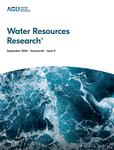Partitioning of Historical Precipitation Into Evaporation and Runoff Based on Hydrologic Dynamics Identified With Recent SMAP Satellite Measurements
Akbar, Ruzbeh , Short Gianotti, Daniel J , Salvucci, Guido D , Entekhabi, Dara
2020-12-01 null null 56(卷), null(期), (null页)
Microwave brightness temperature observations from the NASA Soil Moisture Active Passive (SMAP) mission and gauge-based precipitation data over the United States are used to reconstruct the soil water loss function and then historical (1979-2019) hydrological fluxes in the form of evapotranspiration (ET) and drainage (D) are quantified. Over the period of study, with the exception of snowy and hyper-arid regions, we observe a correlation of R-2 > 0.6 between SMAP-precipitation derived drainage estimates and streamflow measurements from the U.S. Geological Survey (USGS). There is a bias between estimated drainage and USGS streamflow with an underestimation of about 1 mm day(-1) in southwest United States to 3 mm day(-1) in parts of the eastern United States. SMAP-derived sensitivities of drainage and ET partitioning with respect to precipitation anomalies are also calculated. In parts of the Great Plains the drainage partitioning exhibits a near-linear response, while in the southeast United States, the response is nonlinear. Partitioning also is examined for 6 four-digit hydrologic unit basins wherein year-to-year variations in drainage partitioning are shown to be key mediators in translating precipitation anomalies into streamflow anomalies. Observation-driven drainage and ET estimates are obtained without relying on full hydrologic and Land Surface Models (LSMs). This independence (isolation from model parameterization assumptions) provides a path toward using satellite-derived landscape hydrological diagnostics to assess hydrologic models and LSMs as well as to guide their further development.
相关推荐
- DustSCAN: A Five Year (2018-2022) Hourly Dataset of Dust Plumes From SEVIRI [2020-12-01]
- Land Surface Influence on Convective Available Potential Energy (CAPE) Change during Interstorms [2020-12-01]
- Forward Simulation of Multi-Frequency Microwave Brightness Temperature over Desert Soils in Kuwait and Comparison with Satellite Observations [2020-12-01]
- Estimation of latent heat flux using satellite land surface temperature and a variational data assimilation scheme over a eucalypt forest savanna in Northern Australia [2020-12-01]
- A Comparative Study of the SMAP Passive Soil Moisture Product With Existing Satellite-Based Soil Moisture Products [2020-12-01]



